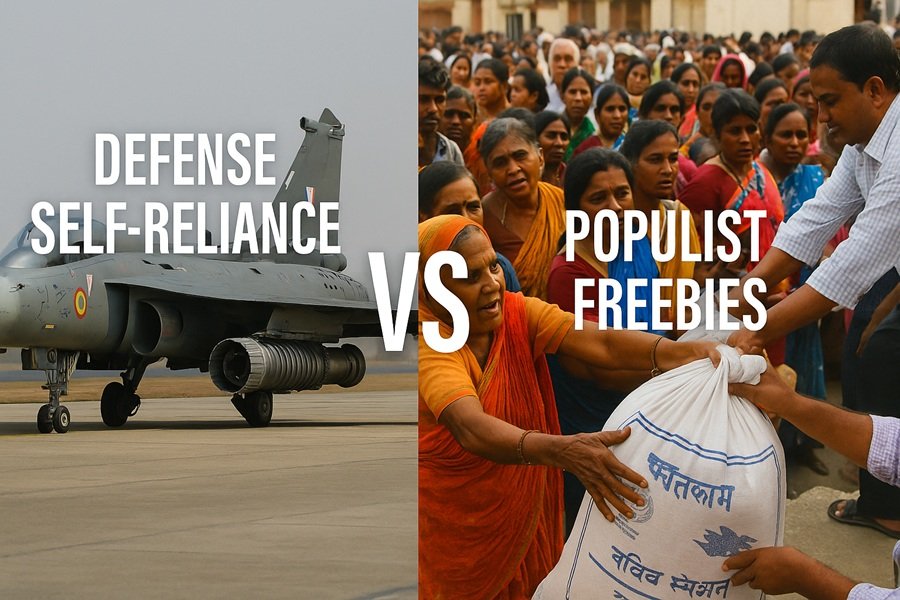
Introduction
India, the world’s most populous democracy and a rising economic power, faces a strategic dilemma: Should it prioritize short-term populism or long-term self-reliance? While the nation has made commendable progress in space, nuclear, and digital technologies, it continues to lag in critical areas like jet engine development, semiconductor fabrication, and advanced defense systems.
The stark contrast between generous political freebies and underfunded indigenous strategic programs like the Kaveri Engine and the Advanced Medium Combat Aircraft (AMCA) raises serious questions about the country’s priorities. This article critically analyzes India’s public spending choices, highlighting the long-term costs of populism at the expense of national self-reliance.
The Reality of Freebie Culture in India
Definition and Types of Freebies
Freebies refer to goods or services given at zero cost or heavily subsidized prices, often with electoral motives. These include:
- Free electricity/water for farmers or households
- Free bus rides for women
- Loan waivers
- Cash transfer schemes
- Free mobile phones, laptops, bicycles
- Subsidized grains beyond targeted welfare norms
Fiscal Impact
According to various Reserve Bank of India (RBI) and Comptroller and Auditor General (CAG) reports:
- States like Punjab, Delhi, Rajasthan, and Tamil Nadu spend a significant share of their budgets (15–30%) on freebies.
- Central schemes such as PM Kisan, free ration under NFSA, and MNREGA also account for massive outlays.
Estimates suggest that India spends over ₹4–5 lakh crore annually on various freebie-based schemes — often without rigorous cost-benefit analysis or measurable productivity outcomes.
The Neglect of Strategic R&D: Kaveri Engine and AMCA
Kaveri Engine: A Symbol of Neglected Innovation
As discussed in previous articles, the Kaveri Engine project was launched in 1986 to develop India’s own jet engine technology. Despite investing over ₹2,800 crore, the project was underfunded, technologically isolated, and eventually dropped for frontline fighter use.
Reasons include:
- Inconsistent political support
- No continuity in leadership or vision
- Budgetary limitations due to other competing “vote-yielding” expenditures
The result? India continues to import engines for Tejas, costing crores in foreign exchange and perpetuating strategic dependency.
AMCA: India’s Stealth Fighter Dream, But Not Yet Fully Funded
The Advanced Medium Combat Aircraft (AMCA) is India’s planned 5th-generation stealth fighter. DRDO and HAL are ready to move into the prototype phase, but the project approval and budget release have been slow. As of early 2025, the AMCA project still awaits full-scale funding for the initial five prototypes.
Meanwhile, billions are spent on social transfers, many of which yield no long-term economic or technological return.
Opportunity Cost: What Are We Losing?
1. Technological Independence
Projects like Kaveri and AMCA help build an ecosystem of engineers, materials, and design expertise. Abandoning or underfunding them creates a vacuum, leaving India dependent on:
- American GE engines
- French Safran turbines
- Israeli and Russian radar systems
This compromises national security and increases vulnerability during geopolitical tensions.
2. Economic Multipliers
Strategic R&D spending leads to:
- Creation of high-skilled jobs
- Growth of ancillary industries (metallurgy, electronics, avionics)
- Export potential of indigenous platforms
On the other hand, unproductive subsidies reduce fiscal space without contributing to long-term growth.
3. Sovereignty in Defense and Space
Countries like the U.S., China, and Russia invest heavily in defense R&D not just for military superiority but also for diplomatic leverage and economic spillovers. India risks missing this global race by sidelining its own capabilities.
Comparing Global Spending Priorities
| Country | Strategic R&D Focus Areas | Welfare Populism Share |
|---|---|---|
| USA | DARPA, NASA, Lockheed Martin Projects | Moderate |
| China | Jet engines, AI, Hypersonic Weapons | Low (tightly controlled) |
| France | Rafale, Safran Engines | Balanced |
| India | DRDO, ISRO (underfunded) | High and rising |
China, for instance, invested over $7 billion in jet engine development in the last decade, enabling it to field engines like WS-10 and WS-15 for its fighter jets. India, in contrast, shelved its most promising engine project due to underperformance — largely traceable to insufficient sustained funding.
Political Economy of Freebies: Why Do They Persist?
Electoral Calculus
Political parties use freebies as short-term vote magnets, especially in states with economically vulnerable populations. Welfare schemes have emotional appeal and visible impact, unlike long-gestation projects like Kaveri.
Lack of Public Pressure for R&D
Unlike roads, food, or electricity, the benefits of indigenous engine technology are not immediately visible to the common citizen. As a result, there is minimal electoral incentive to fund these programs.
Bureaucratic and Procurement Red Tape
Many indigenous programs get bogged down in:
- Delayed tendering processes
- Changing specifications
- Delays in cabinet approvals
This lack of policy continuity is in sharp contrast to the swift rollouts of mass welfare schemes.
The Way Forward: Balancing Welfare with Strategic Investment
1. Reclassify Strategic Projects as National Priorities
Projects like Kaveri, AMCA, Ghatak UCAV, and indigenous satellite navigation must be treated like national infrastructure, receiving assured multiyear funding.
2. Cap Fiscal Freebies Without Measurable Outcomes
Introduce a Freebie Evaluation Commission to assess the economic viability and long-term utility of state and central schemes.
3. Public Awareness and Tech Patriotism
Educate the public on how self-reliant tech projects create jobs, exports, and security — building the narrative that “Make in India” is not just a slogan but a strategic necessity.
4. Encourage PPP in Defense Tech
Private players must be incentivized to co-invest in defense engines, radars, avionics, and weapon systems. Reliance on only DRDO and HAL limits agility.
Conclusion: India Must Choose Wisely
India stands at a critical juncture. While welfare schemes are important in a developing country with widespread poverty, unchecked freebies that compromise national self-reliance are unsustainable. Defense technology, aerospace engineering, and scientific innovation must not be sacrificed at the altar of short-term populism.
The Kaveri Engine and AMCA are not just defense programs — they are metaphors for India’s struggle between strategic vision and electoral expediency. The sooner we shift the balance in favor of long-term national interest, the stronger and more sovereign India will become.







